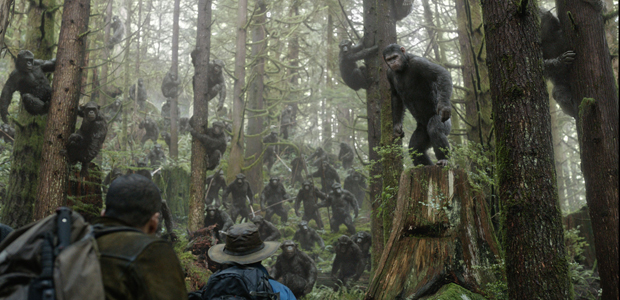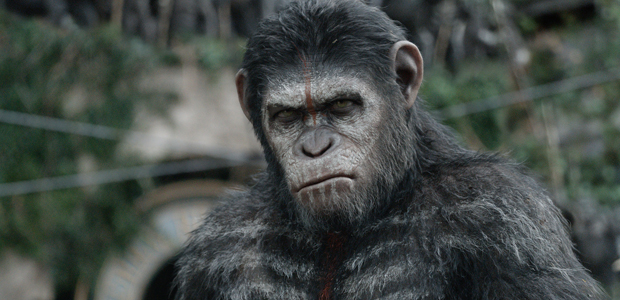
The Evolution of the Species
An evening with Dawn of the Planet of the Apes, directed by Matt Reeves
The evolution of the evolution of the apes in Planet of the Apes has been miraculous. Archeologists refer to this sort of sudden spurt of advancement as punctuated equilibrium, and lately, since the newest reload, we’ve seen what is a virtual Cambrian Explosion of special effects in film. Back in the murk of the Paleolithic epoch, circa 1968, the make-up artist John Chambers won an Academy Award for Outstanding Achievement in Make-up for the original film (Franklin J. Schaffner, 1968). (He was also, incidentally, the man responsible, for Mr. Spock’s ears.) Chambers’ work was groundbreaking and he is considered the father of modern film make-up (‘modern,’ of course, being somewhat relative, like saying ‘the modern Neanderthal’). Instead of one big rubber head, as had been the norm (see The Mighty Gorga, 1969), Chambers used articulated tectonic plates of latex ape skin on Roddy McDowall, Kim Hunter, and Maurice Evans (even Edward G. Robinson for a time). And they kept their real Roddy McDowall eyes.
Recently, in London, the basement of a Soho hotel, Andy Serkis presented clips from the newest installment, Dawn of the Planet of the Apes. Like the best university lecturer you ever had, one who is giddy with wonder and enthusiasm and erudition—he said he was, ‘ecstatic, thrilled, delighted’ to be there— he took us through the recent developments of that much studied phylum of organism, the movie creature. And he was not alone. With him were (and not only for our edification but also as an indication of Fox’s confidence that they got things right) Evolutionary Psychologist, Carole Jahme and Volker Sommer, Professor of Primatology at University College London.

Serkis gave us the story of this recent series thus far: the great apes (excluding humans) have moved, as we saw them do last time, into the great redwood forests of Muir Woods in Marin Country, on the more idyllic side of the Golden Gate Bridge. It’s 10 years on since the last film, not too distant from our last encounter, because, as Serkis said, director Matt Reeves ‘wanted to enjoy the process of evolution—we know what happens, we just never found out how we get there.’ Of course, in the mythology of Planet of the Apes, we kind of do know, though, because in Escape From the Planet of the Apes Cornelius and Zira go back in time to escape the end of the world (which blew up in Beneath the Planet of the Apes and traumatized me as a boy) and face a less devolved (linguistically, certainly not morally) human population in 1970s Los Angeles, where they become the Adam and Eve of the Planet of the Apes by giving birth to a talking chimp named Milo. Anyway, in San Francisco this time around, there are two completing groups of surviving hominidae—us versus a consortium of the other species—the humans in decline, and the ape colony on the incline, led by Caesar (Serkis), the chimpanzee raised by James Franco in the first (new) installment.
‘In the first part of the film,’ Serkis says, ‘the audience is submerged in the ape world. It’s very evolved, with aqueducts, due to Caesar’s technical understanding. As the apes watch the lights dim in San Francisco, they believe that humans are all but extinct.’ (The lights are dimming a lot in San Francisco this summer, the go-to city for mutant animal warfare.) But of course the humans are not extinct. Their civilization is struggling, and power has become a huge currency for humans to keep those dimming lights on. Apes, of course, are used to surviving in trees. ‘Humans are desperate. But there are no winners or losers—everyone suffered,’ Serkis says, ‘Caesar sees good and bad in both sides. He grew up with humans.’ The colony he’s establishing in Muir Woods is ‘utopian, incorporating things he learned in his human upbringing. He’s searching for a peaceful conduit.’ He’s drawn to simian nature, but also still attached to notions of man’s version of civilization, with a little bit of humanist in him (unlike the Republican gorillas, snorting and militaristic and not inclusive, who just want to go to war with the humans, or the reactionary humans, who want to blame the apes for the destruction they themselves caused). ‘It’s about prejudice on both sides,’ Serkis says, ‘Matt wanted to balance that out, not blame either side. Caesar’s journey is the backbone, as he’s the one straddling both worlds. Yes, it’s a summer blockbuster, but at the heart is an emotional thread.’
To get that you need a lot more than rubber plates glued on. Those apes, the Roddy McDowall ones, could talk, certainly, but couldn’t really, I don’t know, blow a kiss. Or whistle. Caesar is more upright now. More cornea, and with a more homo sapiens palette in the iris. ‘It’s an actor’s film,’ Serkis says, ‘filmed on location in the woods, shooting 3D native outside Vancouver. It was real rain, we were knee-deep in mud, wet, with hulking 3D cameras. Fitzcarraldo [Werner Herzog, 1982] is a good comparison.’ And in New Orleans, where they shot the ape community scenes, where they worked in ‘100% humidity—you don’t want to stand next to someone in a motion capture suit for four hours.’ There were no CGI crowds; 15 ape-performers—actors, parkour, gymnasts—played 2000 apes. There’s ‘very little key frame animation. This should be performance capture, very little digital doubling.’
Serkis approached playing Caesar ‘as human in ape skin—all the choices were based on a real chimp in the 1970s called Oliver.’ Oliver was a chimp captured in Africa and brought to New Jersey to be trained as a show animal. Oliver—bald, with human-like pointed ears, a flatter face, and a penchant for walking bipedally—was alternately called the ‘humanzee,’ ‘the missing link,’ and ‘Big Foot in New York.’ As Serkis has played Caesar from infant to revolutionary, ‘the conflict never goes away for him, dealing with leadership, empathy.’ One of the key drives for Reeves was to show the development, to ‘show apes speaking. All the actors playing apes went to “ape camp” and developed behaviors such and how they work as a group and ape vocalizations. And, most importantly, how to develop an organ for language.’
Is such a thing possible? Carole Jahme discussed the possibility of other apes besides humans being able to talk. Caesar, in the first film, was taught ASL, just as Lucy, a chimpanzee raised by a couple of scientists in the 1960s, learned over 140 signs in American Sign Language, and even, upon being rehabilitated into the jungle in Gambia, was observed teaching sign language to other chimps. So, she said, other apes do in fact have the wiring for language, just not the biology we do for vocalizing it. Human necks are much longer, the result of walking upright, and, as a result, our larynges have slid down somewhat, making speech possible. It’s not a great thing, really, evolutionarily. Very much in the compromise column; we can talk, yes, but we can’t breathe and eat at the same time without choking to death. I think, personally, if I were living in the jungle, I’d rather be able to flee from danger when I was eating. When asked what would be the first thing apes would say if they could talk, Jahme said, ‘Let’s shag, let’s eat.’ And when asked if apes would like this film, she said, ‘apes love watching stuff. They love wrestling, sports, they love King Kong. Yes, some captive apes will watch this.’ That would prove, in movie marketing terms, a 5-quandrant success.

Volker Sommer has spent decades living amongst the apes, decades in the jungle. He says the big message is, ‘We think it’s fantasy that they’re people, but it’s not.’ Generally, anthropomorphism is a foolish thing for biologists, and a dangerous thing for anyone over 5-years-old (see Timothy Treadwell in Grizzly Man). But, Volker points out, these animals have ‘hopes, emotions, thoughts, feelings…[The Rise of the Planet of the Apes] is a missionary film.’ And we’re also finding out they’re capable of a lot more than we suspected. ‘We see advances in human society because it’s the cumulative effort of humans who we’ve been studying and keeping records for thousands of years. Only about ten groups of wild apes have been studied. That’s only 190 years of total observation time put together. New things are learned every year. Apes use tools—this was first seen only eight years ago—but now we’ve observed that they use different tools in the same job—they’re methodical. But it’s not just technology. More importantly, it is about social interaction, the mental cosmos, storytelling. We just don’t know enough about non-human apes yet.’ He also said that he was only appearing on the panel, only associating with the film or Fox pictures, because no real animal actors were used to make the film. Which, as he points out, is animal abuse: ‘in show biz it’s a disgrace.’
Serkis explained that the motion capture and CGI at Weta (who also did Lord of the Rings) has evolved faster than Caesar in James Franco’s condo. ‘Performance capture has moved on…actors performances are manifested finally on screen. All the choices, the emotions, are authored by the actor on the set.’ And he showed us. He showed the actors, on the location, on the sets, not isolated in a green screen aquarium, side by side with the footage where they’d been turned more simian. It was startling. The new faces were without a doubt the performers’—every twitch, every facial subtlety—and the CGI was really nothing more obtrusive than make-up. ‘What is brilliant,’ Serkis said, ‘is that it’s just digital dress-up for actors who love transformation. It’s a new age for actors because new actors just see it as a logical extension. They’ve grown up with video games and Kinect, and understand connection between actor and avatar.’ Dawn of the Planet of the Apes is about the ‘delicacy of performance, which is unusual in a blockbuster,’ which tends to focus on spectacle. ‘I guess we get lucky because both are rewarded at the same time—human subtlety, and the more subtle the more impressive, is the special effect.’ What makes the CGI future especially rosy is that Serkis’ own motion capture company, Imaginarium, is being lead by an actor, so performance will always be paramount. Their remit is ‘how are stories going to be told in ten years’, twenty years’ time?’ The question, coming from Serkis, seems rhetoric; I have a feeling he’s going to be the one to show us.






COMMENTS